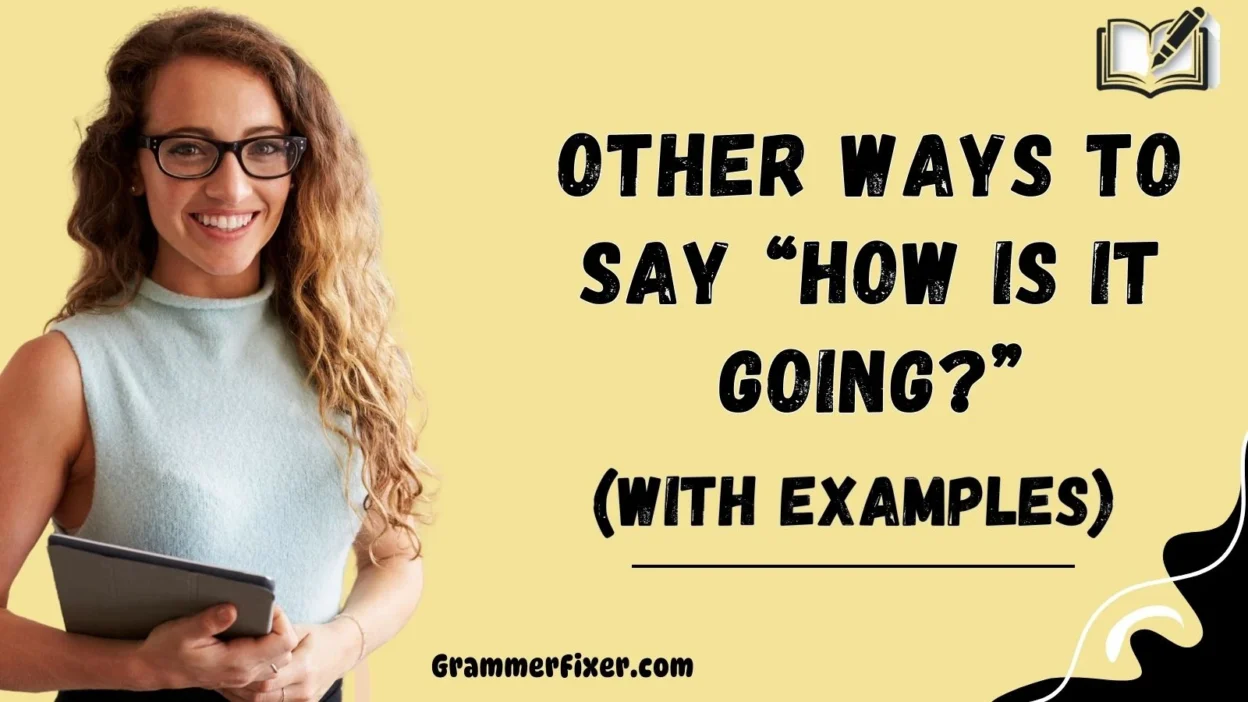Finding the right words to express care, warmth, and genuine interest can transform even the simplest conversation. The phrase “How is it going?” is one of the most common greetings, but it can sometimes feel automatic, overused, or uninspired. By using thoughtful alternatives, you can make your interactions more personal, engaging, and empathetic.
Below, you’ll find 30 creative ways to replace this familiar phrase, each with meanings, scenarios, tone, and examples to help you connect in a meaningful way.
What Does “How Is It Going?” Mean?
The phrase “How is it going?” is a casual, conversational way of asking about someone’s general situation, well-being, or progress. It’s less formal than “How are you?” and is often used among friends, colleagues, or acquaintances as a friendly check-in.
When to Use “How Is It Going?”
You can use it in informal settings, such as when greeting a friend, catching up with a colleague, or even during casual business interactions. It works well in daily conversations, but sometimes it may feel generic, which is why alternatives are helpful.
Is It Professional/Polite to Say “How Is It Going?”
Yes, but context matters. It’s considered polite and professional enough in casual workplace interactions, especially when paired with a friendly tone. However, in formal environments (like an interview or first-time client meeting), a more specific or polished phrase may be better.
Pros or Cons
Pros:
- Friendly and approachable
- Easy to use in everyday conversations
- Encourages connection
Cons:
- Can feel generic or impersonal
- Sometimes doesn’t invite detailed responses
- Risks sounding like an automatic, autopilot greeting
1. What’s Up?
Meaning: A very casual and informal way to check on someone’s current state or activities.
Detailed Explanation: Often used among friends or peers, it’s short, relaxed, and friendly, though not ideal for formal situations.
Scenario Example: “Hey Sam, what’s up? Haven’t seen you in a while.”
Best Use: Casual encounters with friends or acquaintances.
Worst Use: In a professional meeting or email, as it may sound too slangy or dismissive.
Tone: Laid-back, upbeat, and easygoing.
2. How Have You Been?
Meaning: A warmer and more personal alternative that asks about someone’s life since your last meeting.
Detailed Explanation: Implies genuine interest in someone’s recent experiences, especially if you haven’t spoken in a while.
Scenario Example: “It’s been ages since we last met—how have you been?”
Best Use: Reconnecting with old friends, former colleagues, or distant family.
Worst Use: When speaking to someone you just saw yesterday, as it might feel unnatural.
Tone: Thoughtful and caring.
3. How Are Things?
Meaning: A general and versatile inquiry about someone’s life or work.
Detailed Explanation: Broad enough to cover different contexts, without sounding too intrusive.
Scenario Example: “Hi Emma, how are things at your new job?”
Best Use: Suitable for workplace chats or personal catch-ups.
Worst Use: With someone going through a serious hardship, since it may sound too casual or vague.
Tone: Friendly and balanced.
4. What’s New With You?
Meaning: An invitation for someone to share updates about their life.
Detailed Explanation: Encourages the other person to talk about recent changes, events, or milestones.
Scenario Example: “Hey Chris, what’s new with you these days?”
Best Use: Great for catching up after a gap.
Worst Use: During a quick greeting in passing, as it may require more time for a proper response.
Tone: Engaging and curious.
5. How’s Everything Coming Along?
Meaning: A more specific way of asking how things are progressing.
Detailed Explanation: Works well in both personal and professional conversations, especially about projects or life changes.
Scenario Example: “How’s everything coming along with your moving plans?”
Best Use: Work-related updates or personal projects.
Worst Use: As a casual hello without context, since it implies you expect details about progress.
Tone: Encouraging and supportive.
6. Everything Alright?
Meaning: A quick way to check on someone’s well-being, often when you suspect something is off.
Detailed Explanation: Shows concern and empathy, but can also sound a bit serious if the other person is doing fine.
Scenario Example: “You’ve been quiet in the meeting today—everything alright?”
Best Use: When you notice a change in someone’s mood, behavior, or performance.
Worst Use: As a general greeting, since it may accidentally worry the person.
Tone: Caring, serious, and empathetic.
7. How’s Your Day Looking?
Meaning: A polite way to ask about someone’s schedule, availability, or workload for the day.
Detailed Explanation: This phrase shows that you’re interested in their plans, busyness, or how manageable their day seems, rather than just asking about well-being.
Scenario Example: “Hey, how’s your day looking? Want to grab coffee later if you’re free?”
Best Use: When you need to coordinate plans or check on a colleague’s workload.
Worst Use: As a casual hello when you’re not actually interested in their schedule.
Tone: Professional, considerate, and practical.
8. What’s Going On?
Meaning: A casual check-in about what someone is currently doing or experiencing.
Detailed Explanation: Friendly and versatile, but depending on tone, it can either sound like a warm greeting or a serious question.
Scenario Example: “Hey Alex, what’s going on? Haven’t seen you at the gym lately.”
Best Use: With friends, acquaintances, or colleagues in relaxed conversations.
Worst Use: In sensitive situations, where it might sound confrontational (e.g., during conflict).
Tone: Flexible—casual or serious depending on delivery.
9. How Are You Doing?
Meaning: A slightly more formal version of “How’s it going?”, often seen as polite and friendly.
Detailed Explanation: This phrase communicates genuine interest and works across many contexts.
Scenario Example: “Hi Mrs. Patel, how are you doing today?”
Best Use: In professional and polite interactions, such as with clients, teachers, or new acquaintances.
Worst Use: In very casual encounters with close friends, where it might feel too stiff.
Tone: Warm, respectful, and conversational.
10. All Good?
Meaning: A short and casual way of asking if someone’s life or situation is going smoothly.
Detailed Explanation: Often used in informal settings; it’s light and friendly, but can sometimes seem dismissive.
Scenario Example: “Hey man, all good? Haven’t heard from you in a bit.”
Best Use: With friends or colleagues in laid-back environments.
Worst Use: In professional emails or formal meetings—it may sound careless.
Tone: Relaxed, informal, and friendly.
11. How’s Life Treating You?
Meaning: A warm, slightly philosophical version of asking how things are going overall.
Detailed Explanation: It suggests you’re interested in their bigger picture, not just their current day.
Scenario Example: “It’s been a while since we caught up—how’s life treating you?”
Best Use: With old friends, classmates, or colleagues you’re catching up with after some time.
Worst Use: In a quick office hallway greeting, since it sounds deeper than small talk.
Tone: Thoughtful, reflective, and empathetic.
12. How’s Your Week Going?
Meaning: A specific and time-focused version of “How is it going?”
Detailed Explanation: Instead of being broad, this focuses on the person’s week as a whole.
Scenario Example: “Hey Sarah, how’s your week going so far?”
Best Use: Great for mid-week conversations with colleagues or friends.
Worst Use: On a Monday morning (too soon for an update).
Tone: Friendly, situational, and time-aware.
13. How’s Everything on Your End?
Meaning: A polite way of checking in, especially in professional or collaborative contexts.
Detailed Explanation: Often used in emails or team projects, showing consideration for how things are progressing for the other person.
Scenario Example: “We’ve wrapped up our side of the project—how’s everything on your end?”
Best Use: In business or teamwork settings.
Worst Use: In casual chats with friends—it may sound overly formal.
Tone: Professional, respectful, and collaborative.
14. How’s It Shaping Up?
Meaning: A progress-focused way to ask about how something is developing.
Detailed Explanation: Often tied to work projects, plans, or ongoing efforts.
Scenario Example: “How’s it shaping up with the new campaign launch?”
Best Use: Work-related conversations about projects or deadlines.
Worst Use: In a personal wellness context, since it might sound cold.
Tone: Focused, professional, and supportive.
15. How’s Everything Flowing?
Meaning: A more creative twist on asking if things are going smoothly.
Detailed Explanation: Casual and slightly playful, it gives a fresh variation to the common check-in.
Scenario Example: “How’s everything flowing at work these days?”
Best Use: With friends or coworkers when you want to keep the tone light.
Worst Use: In a formal email, where it may sound unprofessional.
Tone: Playful, casual, and friendly.
16. How’s It Coming Along?
Meaning: A progress-oriented way to ask how someone is managing with a task, project, or situation.
Detailed Explanation: Similar to “How’s everything coming along?”, but slightly more direct and focused.
Scenario Example: “How’s it coming along with your presentation prep?”
Best Use: Work-related check-ins or project updates.
Worst Use: In personal chats where no specific task is involved—it may confuse the other person.
Tone: Professional, supportive, and practical.
17. How’s the Week Treating You?
Meaning: A casual way of checking in on how someone’s week has been going.
Detailed Explanation: A little more personal than work-focused, it asks about general mood and flow of the week.
Scenario Example: “Hey James, how’s the week treating you so far?”
Best Use: For mid- to late-week conversations with colleagues, friends, or acquaintances.
Worst Use: In very formal settings, as it may sound too casual.
Tone: Friendly, considerate, and engaging.
18. How’s Your Day Going?
Meaning: A direct yet caring way of asking about someone’s immediate day.
Detailed Explanation: This keeps the focus time-specific and works in most settings.
Scenario Example: “Hi Anna, how’s your day going so far?”
Best Use: Everyday check-ins with colleagues, friends, or service staff.
Worst Use: In a deep catch-up after months, since it’s too narrow for that context.
Tone: Casual, warm, and approachable.
19. How Are You Managing?
Meaning: A thoughtful phrase that shows concern for someone’s ability to handle tasks or challenges.
Detailed Explanation: Often used when someone is busy, stressed, or facing difficulties, showing empathy and care.
Scenario Example: “You’ve had so much on your plate lately—how are you managing?”
Best Use: With a colleague, friend, or family member going through a challenging time.
Worst Use: As a generic greeting, since it may sound too heavy when nothing is wrong.
Tone: Empathetic, caring, and supportive.
20. How’s Everything Settling In?
Meaning: A situational phrase often used when someone is starting something new—job, house, or routine.
Detailed Explanation: Focuses on adjustments, transitions, and new experiences.
Scenario Example: “Congrats on the new apartment! How’s everything settling in?”
Best Use: With someone in a new phase of life (job, school, home, relationship).
Worst Use: In random conversations where no transition is involved.
Tone: Supportive, warm, and thoughtful.
21. How’s It Going on Your Side?
Meaning: A balanced and polite way to check on someone’s situation, especially in collaboration.
Detailed Explanation: Often used in work or partnership contexts, it emphasizes mutual progress.
Scenario Example: “We’ve finished testing—how’s it going on your side?”
Best Use: Emails, business updates, team collaborations.
Worst Use: In personal small talk, where it might sound too formal.
Tone: Polite, professional, and cooperative.
22. How’s the Journey Going So Far?
Meaning: A metaphorical way of asking how someone is progressing in a long-term effort.
Detailed Explanation: Suited for conversations about projects, goals, or life changes.
Scenario Example: “You’ve been learning guitar for months now—how’s the journey going so far?”
Best Use: With people who are pursuing goals or transitions.
Worst Use: In quick, casual greetings, since it implies depth.
Tone: Encouraging, reflective, and supportive.
23. How’s Your Workflow Going?
Meaning: A direct way to check on someone’s work pace or process.
Detailed Explanation: Typically used in a professional setting to check productivity or challenges.
Scenario Example: “How’s your workflow going with the new project management tool?”
Best Use: In team discussions or work check-ins.
Worst Use: With friends or family, since it’s work-specific.
Tone: Professional, straightforward, and process-focused.
24. How’s the Process Going?
Meaning: A project-focused inquiry about ongoing progress.
Detailed Explanation: Can apply to work tasks, personal goals, or even daily routines.
Scenario Example: “How’s the process going with your job applications?”
Best Use: For projects, procedures, or long-term commitments.
Worst Use: In lighthearted greetings, since it may feel overly technical.
Tone: Practical, professional, and focused.
25. How Are Things Progressing?
Meaning: A polite phrase to ask about the advancement of tasks or situations.
Detailed Explanation: Sounds professional and formal, making it great for work-related contexts.
Scenario Example: “How are things progressing with the merger talks?”
Best Use: In business meetings, professional check-ins, or updates.
Worst Use: In casual social settings, where it may feel too stiff.
Tone: Formal, respectful, and progress-driven.
26. How’s Everything Going With You?
Meaning: A slightly warmer and more personal twist on the original phrase.
Detailed Explanation: Adds a personal touch by focusing on the individual.
Scenario Example: “Hey, how’s everything going with you these days?”
Best Use: In personal catch-ups where you want to show interest in the person, not just events.
Worst Use: In strictly professional emails, where shorter phrasing works better.
Tone: Friendly, conversational, and personal.
27. How’s the Planning Going?
Meaning: A specific inquiry about organization and preparation efforts.
Detailed Explanation: Best for events, projects, or personal milestones.
Scenario Example: “The wedding is only two months away—how’s the planning going?”
Best Use: With people working on specific plans or events.
Worst Use: As a general greeting without context—it doesn’t make sense.
Tone: Supportive, curious, and situational.
28. How’s Everything Flowing Together?
Meaning: A softer, more creative version of asking if things are progressing smoothly.
Detailed Explanation: Suggests interest in how different parts of life or work are balancing out.
Scenario Example: “How’s everything flowing together with work and family these days?”
Best Use: When someone is juggling multiple responsibilities.
Worst Use: In formal corporate exchanges, as it may sound too casual.
Tone: Encouraging, holistic, and empathetic.
29. How’s It All Settling Into Place?
Meaning: A thoughtful way to ask if things are stabilizing after a change.
Detailed Explanation: Often used after someone starts a new chapter or experience.
Scenario Example: “You’ve been at your new job a month now—how’s it all settling into place?”
Best Use: For transitions—new jobs, relocations, or routines.
Worst Use: As a generic hello, since it’s very situational.
Tone: Supportive, patient, and considerate.
30. How’s Your Side of Things Going?
Meaning: A polite way to ask about someone’s current situation, perspective, or workload.
Detailed Explanation: Balances both professional and personal contexts, making it versatile.
Scenario Example: “We’re doing fine here—how’s your side of things going?”
Best Use: For teamwork, partnerships, or distant relatives/friends.
Worst Use: In very casual chats with close friends, where it may sound overly formal.
Tone: Polite, neutral, and considerate.
Conclusion
Saying “How is it going?” is a friendly, common way to initiate conversation—but it can feel automatic and stale if overused. By exploring these 30 thoughtful alternatives, you can tailor your greetings to be more empathetic, specific, and engaging.



